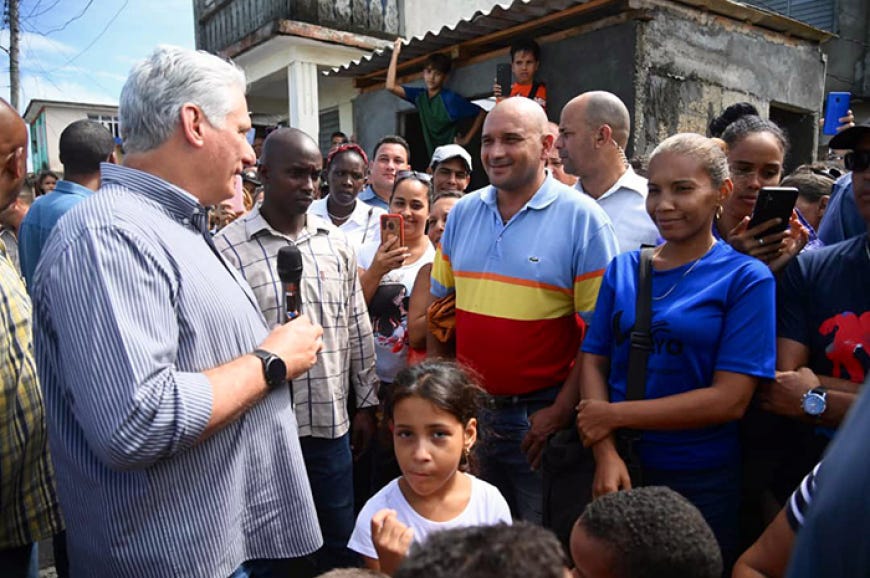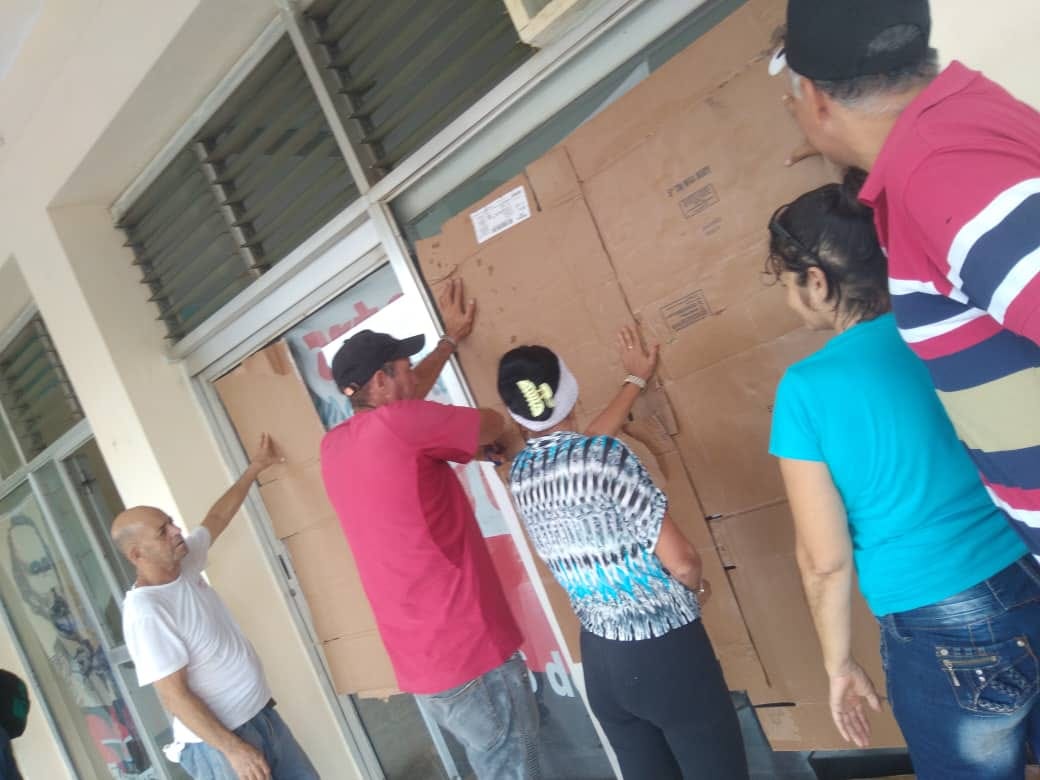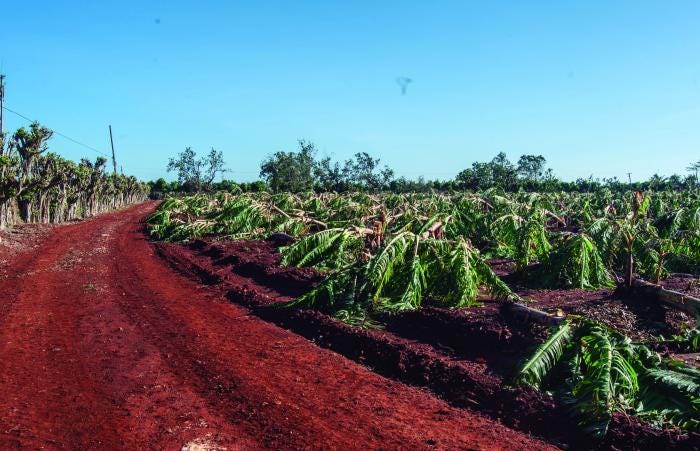From October 18 to October 22, Cuba experienced a power blackout, caused by a shortage of fuel oil and the aging condition of the power infrastructure, both consequences of the intensification of the economic, commercial, and financial blockade of Cuba since the Trump administration, with measures aggressively pursuing companies and banks in third countries, a policy continued to the present by Biden. On October 21, the eastern province of Guantanamo was struck by Hurricane Oscar, causing extensive damage from winds and flooding. See “The causes of the power blackout in Cuba: The collapse and reestablishment of the national electrical system,” October 25, 2024.
The maturity and positive spirit of the people and the high-quality and dedicated leadership of the government and the Party in response to these politically provoked and natural disasters has been impressive. Civil defense response has been rapid, and the people across the island have mobilized to form reconstruction brigades and to send supplies. Many youth who were involved in the efforts were interviewed on Cuban television, emotionally expressing their solidarity with the people and their support of their nation and their revolution. On his fourth visit to Guantanamo on October 30, Cuban President Miguel Díaz-Canel declared, “I am struck by our people’s resilience.”
Guantanamo and the eastern provinces
Guantanamo is known to many Americans as the name of an illegal military base, irreverently called Gitmo by its occupiers. But Guantanamo is also one of the fifteen provinces of the island, where the people live and work with scarcely any contact with the U.S. military base, which occupies an important natural bay.
Cuban news on Sunday, November 3, devoted nearly its entire hour to news reports from the provinces of Guantanamo, Santiago de Cuba, and Granma at the eastern end of the island. The reports consisted of interviews with officials of Cuban Civil Defense and the Party, explaining the measures that are being taken to protect lives and property. Cuba’s civil defense has been recognized internationally for its outstanding organization of preparations prior to the arrival of storms. The Cuban news system does not send Havana-based reporters to the localities; rather, it relies on the professionality of reporters who work at the level of the province, who are committed to informing the nation on what is transpiring in the areas most impacted by the storms.
With the impact of Oscar and then another rainstorm, Guantanamo has been central to the news reports in recent days. News reporter Zandra has emerged as the voice and the face of Guantanamo during these days. Confident, well-spoken, calm, and committed to informing the people of Cuba, she serves as the provincial anchor of four reporting teams who are working throughout the province. Without diminishing the bad news caused by the storm itself, the team focuses on the determined efforts of Civil Defense of the province to ensure the safety of all persons and to protect property as much as possible. They are not looking for sensational stories that might attract ratings or clicks; for these professional journalists of Cuba, the story was the preparedness of the nation to respond to meteorological events, which the people need to understand and appreciate.
During the November 3 midday national news, in anticipation of a new hurricane, Zandra and her teams reported on the evacuation of 65,000 people in Guantanamo, due to their living in housing that was vulnerable to strong winds or flooding. The video footage showed the calmness of the people as they waited on a bus, ready to depart with shoulder bags and backpacks in hand, ready for departure for relatives on safer ground or to evacuation centers. Videos also viewed the major reservoirs and dams in the provinces, reporting on evaluations being made with respect to the capacity of the system to control the new inundation of water. Like their colleagues in other provinces, the Guantanamo team focused on interviewing those who were the persons responsible for leading the preparation, so that the people would be well informed with respect to the preparations being made.
Artemisa and the western provinces
On November 4, Cuban Civil Defense, taking into account the predictions of the Institute of Meteorology of the likely organization of a hurricane from a tropical depression located south of Jamaica, decreed a Phase of Alert for the provinces of Matanzas, Mayabeque, Havana, Artemisa, Pinar del Río, and the Island of Youth. The Councils of Defense for these provinces initiated preparations. The new meteorological event, given the name tropical storm Rafael, was projected to be of hurricane strength by the time of its impact. It was expected to touch land in the province of Artemisa, with wind and rain expected for all the provinces, including strong winds in the eastern provinces, already impacted by two recent hurricanes.
In Artemisa, on November 4, the Provincial Council of Defense distributed 80 tons of agricultural and animal food products to the population and placed 107 tons in storage.
Various ministers of the government participated in the civil defense effort. The Minister of Agriculture, Ydael Pérez Brito, announced measures for the protection of 8,000 tons of tobacco in the westernmost province of Pinar del Río, the heart of the tobacco growing region. In addition, measures were taken to protect the cultivation and seeding houses in nearby provinces. Pérez Brito also announced the drainage of plantations that were at risk of flooding; the relocation of cattle to high places; the anchoring of irrigation machines and the deflating of their tires; the hauling of firewood and coal; the surveillance of dams and micro-dams; and the immediate harvesting of crops, such as bananas; among other measures. The Minister of Energy and Mines, Vicente de la O Levy, announced that the electricity brigades were prepared to restore the damage done by Rafael to the networks of distribution.
On November 5, the Council of Ministers of the Cuban government, headed by Cuban President Diaz-Canel, met in extraordinary session in the face of the imminent arrival of Rafael on Cuban territory. The Council reviewed the preparations that are underway in all the western provinces. The session included the participation by videoconference of the highest governmental authorities of the provinces of Pinar del Río, Artemisa, Havana, Mayabeque and Matanzas as well as the Island of Youth. They reported on the evacuation of persons in vulnerable housing or areas (using buses, trucks, and tractors) to the houses of relatives or to evacuation centers, the distribution of food to the evacuation centers, the protection of material goods (with special emphasis on maritime vessels, roofs, communication towers, rooftop water tanks, among others), the early harvest of crops, the sale of food to the population, and the preparation of generators in the most sensitive places. They also described the work that is being carried out to clean sewers, drains, and channels that could obstruct the passage of water and cause flooding. The General Director of the Institute of Meteorology, Celso Pazo Alberdi, also was present to help the Council of Ministers to predict the provinces and areas that would be most likely impacted. In the evening, provincial councils of defense also held video conferences to review the measures being taken.
Rafael attained the category of hurricane shortly after 7:00 p.m. on November 5, as it continued movement toward Cuba. On November 6 at 6:00 a.m., a decree of the Fase of Alarm went into effect for the provinces of Artemisa, Sancti Spíritus, Cienfuegos, Matanzas, Mayabeque, Havana, and Pinar del Río, as wells as the Special Municipality of the Island of Youth. At 7:00 a.m., Hurricane Rafael attained category 2 on the Saffir-Simpson scale, with sustained maximum winds of 100 mph. The early morning hours were characterized by rain and electrical storms in the western and central regions of the country, and high coastal waves. Rafael touched land in the province of Artemisa as a category 3 hurricane at 4:20 p.m. on November 6. It crossed the island from south to north, ripping through the province of Artemisa, leaving Cuba behind at 6:20 p.m. on November 6.
The stage of recuperation was initiated at 10.00 a.m. on November 7. The Artemisan news outlet, el artemiseño, describing Rafael as a ruthless lumberjack, reported at noon that the Provincial Transport Company of Artemisa had begun cleaning fallen trees from the Central Highway since the early morning hours; and the Revolutionary Armed Forces had been deployed to unblock the streets in the blocks near 41st Street.
At 12:30 p.m., el artemiseño reported that Rafael left significant damage in the sector of agriculture and animal husbandry, affecting crops, infrastructure, and equipment. It reported that 9,000 hectares of banana and 3,800 hectares of yuca had been damaged to varying degrees. Vegetable cultivation was damaged, with 1,041 hectares planted between September and October affected. In grain crops, 500 hectares of rice, 700 hectares of beans, 539 hectares of corn, and 58 hectares of soybeans were damaged. Fruit groves, especially mango and guava, were severely hit. In the poultry sector, 6 farms were inspected, where damage was reported to the decks of 21 buildings and 2 warehouses. In pig raising, the roofs of the warehouses of 4 units visited were affected. Tobacco was also damaged, with most of the roofs of the curing barns affected. In coffee cultivation, 357 of the 640 hectares planted were affected. At least 10 irrigation machines were overturned. Local authorities, the report noted, are working to assess the extent of the damage and provide support to affected producers.
At 7:00 p.m. on November 7, el artemiseño reported that the governor of the province, Ricardo Concepción Rodríguez, upon listening to the preliminary evaluation of the damage, called upon the people to keep informed with respect to the reestablishment of electricity and the supplying of water and food. Iscander Morales Suárez, director of the electric company of the province, pointed out that brigades of linemen had already arrived from the province of Ciego de Ávila, and brigades from Pinar del Río and Cienfuegos were on the way.
The governor also called upon the producers to replant as soon as possible. He maintained that the hurricane should not be used as a pretext to not comply with the contracted quantities of production, although the committed dates of delivery will perhaps be extended.
On November 11, the Telecommunications Company of Cuba (Etecsa) reported that the work on the reestablishment of telephone lines was proceeding. In the provinces of Artemisa, Havana, and Mayabeque, 690 telephone posts had been affected by the hurricane, of which 230 have been repaired or replaced. In addition, more than eighty optic fiber and copper cables have been reestablished. This work has enabled the restoration of 47,000 land telephone lines. With respect to mobile phone services, 77% of the towers in Havana are functioning, with 75% in Mayabeque and 40% in Artemisa. Etecsa reported that workers from the provinces of Pinar del Río, Matanzas, Cienfuegos, Villa Clara, Sancti Spíritus, Ciego de Ávila, and Camagüey as well as the Island of Youth have been transported to the three affected provinces.
On November 13, at a meeting of the Council of National Defense, Cuban President Díaz-Canel, functioning in his capacity as President of the Council of National Defense, recognized the manner in which the entire country is working on the recovery, which has included the participation of the Revolutionary Armed Forces and the Ministry of the Interior in the tasks of reconstruction. He also praised the discipline and efforts of the people in the middle of circumstances in which the country has been hit by several natural phenomena. He declared that “the first task is erasing the traces of all those impacts.”
At the meeting of the Council of National Defense, Gladys Martínez Verdecia, President of the Council of Defense of the province of Artemisa, reported that 17,324 housing units and 15,192 hectares of cultivation were damaged. As of the date, 51.2% of the population of the province has access to water services. Only 4.58% of the electrical service clients had access to normal electricity services; 400 generators were operating and providing vital services in the territory. There are 222 persons that remain protected in the evacuation centers.
At the November 13 meeting, Yuniasky Crespo Baquero, President of the Provincial Council of Defense of Mayabeque, reported that 93% of the clients had electrical services reestablished, and 92.2% are receiving water. There are 97 persons who are protected in the evacuation centers.
It was reported in Granma on November 14 that Gladys Martínez Verdecia, President of the Provincial Council of Defense of Artemisa, announced that negotiations are underway with the producers of agricultural and animal products in the province. The plan is to plant again under contracts for delivery of products in 2025. The producers will receive fuel as well as the support of mass organizations.
Martínez noted that electrical service had been restored to 14.5% of the clients in the province by November 13, and 21% ought to be attained by the evening of November 14. Services of the supply of water have been restored for 59% of the population; water is being carried to places where service has not yet been reestablished.
In our apartment near Central Havana, we were without electricity for five days. I spent the time studying the writings of Xi Jinping, some of which I have in book form, while Olga Lidia and her friends in the building played dominos. The break in electrical services means no water, because the city reservoirs need electricity to deliver water to building cisterns, and the buildings need electricity for the pumps to send water from the cisterns to building and apartment tanks. In anticipation of the storm, we made sure our apartment tanks were filled before the electricity was deliberately cut (as a safety measure, to prevent accidents from fallen live cables). During the five days, we used water carefully, and on the fifth day, our neighbor across the hall (who lives alone and has a super reserve tank) gave us a couple of buckets of water.
Our side of the block was without electricity more than most in Havana, because winds had caused a tree to fall and to demolish a transformer a couple of blocks away. The president of the people’s council went to the scene on the third day of the blackout, and he learned that the replacement of the transformer requires a certain technical expertise, and besides there was a high demand for them at the moment. On the fifth day, we went to a patio restaurant across the street so that I could recharge my laptop and do some work. Olga Lidia and her friends drank, ate, and conversed, while I worked on my recharging laptop. We learned from the neighbors passing by in the street that a truck full of transformers had arrived from the eastern province of Granma. Apparently, the truck driver was confused with respect to the exact destination of the fallen transformer. Quite understandably, the neighbors were most willing to help him out. Lo and behold, the lights came back on just as we returned to our apartment, at 7:00 p.m. on November 9.
On November 14, 2024, we learned on the evening television news program Mesa Redonda, that approximately 100 transformers in the City of Havana had been damaged by the storm. Brigades of workers from five neighboring provinces had been organized and were present in Havana prior to the storm, in anticipation of wind damage to posts, cables, and transformers in the city. As of November 14, 99% of electric services in the city had been reestablished. In addition, the panelists on Mesa Redonda pointed out that 5% of land telephone services had been disrupted, and they have been restored; and the water system was fully functioning.
In Havana, things are nearly back to normal. But in Artemisa and Guantanamo, reconstruction and restoration continue.
A free subscription option is available, with capacity to read, send, and share all posts. A paid subscription ($5 per month or $40 per year) enables you to make comments and to support the costs of the column; paid subscribers also receive a free PDF copy of my book on Cuba and the world-system. Ten percent of income generated through subscriptions to the column is donated to the Cuban Society for Philosophical Investigations.
People’s Democracy in Cuba: A vanguard political-economic system





